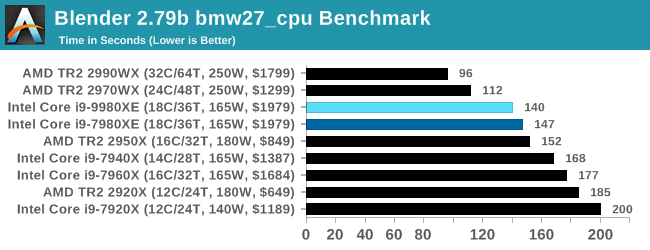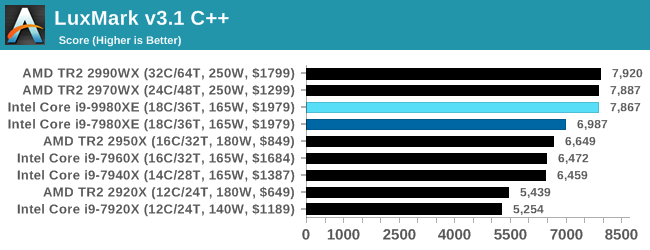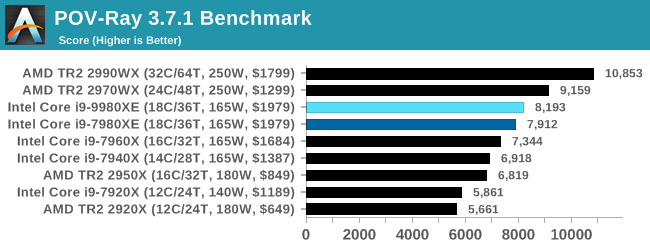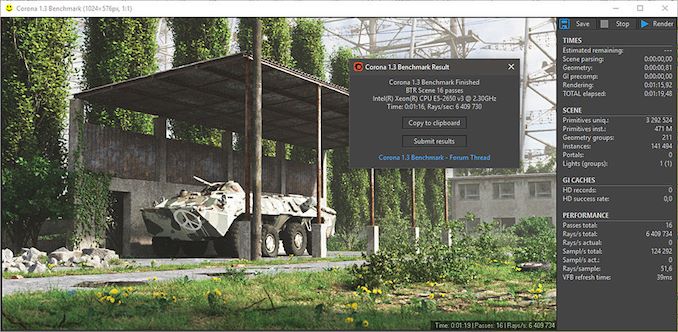The Intel Core i9-9980XE CPU Review: Refresh Until it Hertz
by Ian Cutress on November 13, 2018 9:00 AM ESTHEDT Performance: Rendering Tests
Rendering is often a key target for processor workloads, lending itself to a professional environment. It comes in different formats as well, from 3D rendering through rasterization, such as games, or by ray tracing, and invokes the ability of the software to manage meshes, textures, collisions, aliasing, physics (in animations), and discarding unnecessary work. Most renderers offer CPU code paths, while a few use GPUs and select environments use FPGAs or dedicated ASICs. For big studios however, CPUs are still the hardware of choice.
All of our benchmark results can also be found in our benchmark engine, Bench.
Corona 1.3: Performance Render
An advanced performance based renderer for software such as 3ds Max and Cinema 4D, the Corona benchmark renders a generated scene as a standard under its 1.3 software version. Normally the GUI implementation of the benchmark shows the scene being built, and allows the user to upload the result as a ‘time to complete’.
We got in contact with the developer who gave us a command line version of the benchmark that does a direct output of results. Rather than reporting time, we report the average number of rays per second across six runs, as the performance scaling of a result per unit time is typically visually easier to understand.
The Corona benchmark website can be found at https://corona-renderer.com/benchmark

Corona sees improvement in line with the frequency gain, however the higher core count AMD parts win out here.
Blender 2.79b: 3D Creation Suite
A high profile rendering tool, Blender is open-source allowing for massive amounts of configurability, and is used by a number of high-profile animation studios worldwide. The organization recently released a Blender benchmark package, a couple of weeks after we had narrowed our Blender test for our new suite, however their test can take over an hour. For our results, we run one of the sub-tests in that suite through the command line - a standard ‘bmw27’ scene in CPU only mode, and measure the time to complete the render.
Blender can be downloaded at https://www.blender.org/download/

Similarly with Blender as to Corona: the new Intel Core i9-9980XE performs better than the previous generation 7980XE, but sits behind the higher core count AMD parts.
LuxMark v3.1: LuxRender via Different Code Paths
As stated at the top, there are many different ways to process rendering data: CPU, GPU, Accelerator, and others. On top of that, there are many frameworks and APIs in which to program, depending on how the software will be used. LuxMark, a benchmark developed using the LuxRender engine, offers several different scenes and APIs. *It has been mentioned that LuxMark, since the Spectre/Meltdown patches, is not a great representation of the LuxRender engine. We still use the test as a good example of different code path projections.
In our test, we run the simple ‘Ball’ scene on both the C++ and OpenCL code paths, but in CPU mode. This scene starts with a rough render and slowly improves the quality over two minutes, giving a final result in what is essentially an average ‘kilorays per second’.

Our test here seems to put processors into buckets of performance. In this case, the Core i9-9980XE goes up a bucket.
POV-Ray 3.7.1: Ray Tracing
The Persistence of Vision ray tracing engine is another well-known benchmarking tool, which was in a state of relative hibernation until AMD released its Zen processors, to which suddenly both Intel and AMD were submitting code to the main branch of the open source project. For our test, we use the built-in benchmark for all-cores, called from the command line.
POV-Ray can be downloaded from http://www.povray.org/

POV-Ray is as expected: a performance improvement, but behind the higher core count AMD parts.












143 Comments
View All Comments
imaheadcase - Tuesday, November 13, 2018 - link
Yah because you don't do anything intensive with the jobs you have, of course you would use laptops or whatever mobile. But the reality is most people would use desktops because simply faster to get stuff done, and more powerful.BYOD fyi is not like that for most companies..
imaheadcase - Tuesday, November 13, 2018 - link
..and if you are doing anything intensive with laptops..that just means company you work for is behind the curve and just being cheap and not fork out money for the right hardware.PeachNCream - Tuesday, November 13, 2018 - link
There are over 250K people on the payroll. There ARE desktop PCs around, but they are few and far between. I'm not going to get into an extended debate about this because it won't change anyone's perspective, but I do believe you've got a slight misconception about the usefulness and flexibility of portable computer hardware. A simple look at the availability of desktops versus laptops should be enough to make it obvious, for most people, computer == laptop these days.Spunjji - Tuesday, November 13, 2018 - link
You're eliding the difference between "convenient and sufficient" and "as powerful as anyone needs".I'll absolutely grant that if you're only going to have one system for doing your work and you move around a fair bit, then it absolutely makes sense to have that system be mobile, even if you lose a bit of edge-case performance.
For people doing /serious/ GPU grunt work something like an XPS 15 is going to provide between 1/2 and 1/3 of the power they could get with a similarly priced desktop. That compromise doesn't make any sense for someone whose job does not require mobility.
So sure, notebooks are better than ever for a large number of people. Doesn't make desktops and HEDT chips functionally irrelevant for businesses, though. If you can really use 18 cores for the work you're doing then being provided with an XPS 15 will be, at best, a sad joke.
Ratman6161 - Tuesday, November 13, 2018 - link
Any laptop is essentially on a different planet than any of the processors covered in this review (doesn't matter if we are talking Intel or AMD).1. If it is possible to do your work on a laptop (which I am myself at this very moment) then you (and me) are not the target audience for these CPU's. In fact, I'm not entirely sure why you even bother to read or comment on the story?
2. If you have to ask if you need it, you don't need it.
3. If you have to think more than about 1 second to make a decision between one of these and a laptop, then you don't need it.
4. If you do need one, then you already know that.
Most people don't need one, including me. I read these things because the technology is interesting and because I find it interesting what others might be doing. I don't really feel any need to insist that others need what I need and could not possibly need anything else.
PeachNCream - Wednesday, November 14, 2018 - link
So a differing opinion than yours should mean that someone not read an article or comment on it. That appears to be nothing more than a self-protective mechanism intended to erect a bubble in which exists nothing more than an echo chamber filled with your own beliefs. That's hardly a way to integrate new thinking, but I do understand that a lot of people fear change in the same way you do.Kilnk - Tuesday, November 13, 2018 - link
"But the reality is most people would use desktops because simply faster to get stuff done, and more powerful."See, that's the problem with your reasoning. You assume that most people need power when they do not. The reality is that the majority of people who need to use computers for work do not need to do rendering or any kind of intensive task. So no, most people don't use desktops nor would they want to use desktops given the opportunity. They use laptops.
FunBunny2 - Tuesday, November 13, 2018 - link
"Now we live in a BYOD (bring your own device) world where the company will pay up to a certain amount (varies between $1,100 and $1,400 depending on funding from upper echelons of the corporation) and employees are free to purchase the computer hardware they want for their work. There are no desktop PCs currently and in the past four years, only one person purchased a desktop in the form of a NUC. "The Man's advantage to the Worker Bees using laptops: their always 'on the job'. no time off. as close to slavery as it's legal to be. some smart folks are truly stupid.
PeachNCream - Tuesday, November 13, 2018 - link
"The Man's advantage to the Worker Bees.." (just quoting because of the lack of continuing indents in Anandtech's 1990's-era comment system)I think that's a bit of a stretch in our case. My division doesn't do on-call and we strictly prohibit our lower tier managers from tapping employees outside of their normal work hours. Even checking company e-mail outside of work hours is against posted (and enforced) policy. If we must, due to emergencies, they absolutely have to be compensated for the time regardless of whether or not they are hourly or salaried workers. I haven't seen an "emergency" that couldn't wait until the next day so that policy has not been put into use in at least the last five years. Computational mobility is no excuse to allow invasions into off-the-clock time and I for one won't allow it.
jjjag - Tuesday, November 13, 2018 - link
I hate to admit it but PNC is right. Super-high-powered desktops are an anachronism. If you need REAL horsepower, you build a server/compute farm and connect to it with thin-client laptops. If you are just doing software development, the laptop cpu is usually good enough.This is especially true of single socket monsters like these HEDT chips. The only reason they exist is because gamers will pay too much for everything. It's nothing more than an expensive hobby, and like all hobbies at the top end is all "want" and very little "need". The "need" stops somewhere around 6 or 8 cores.
It's exactly the same as owning a Ferrari and never taking it to the track. You will never use more than 20% of the full capabilities of it. All you really need is a Vette.